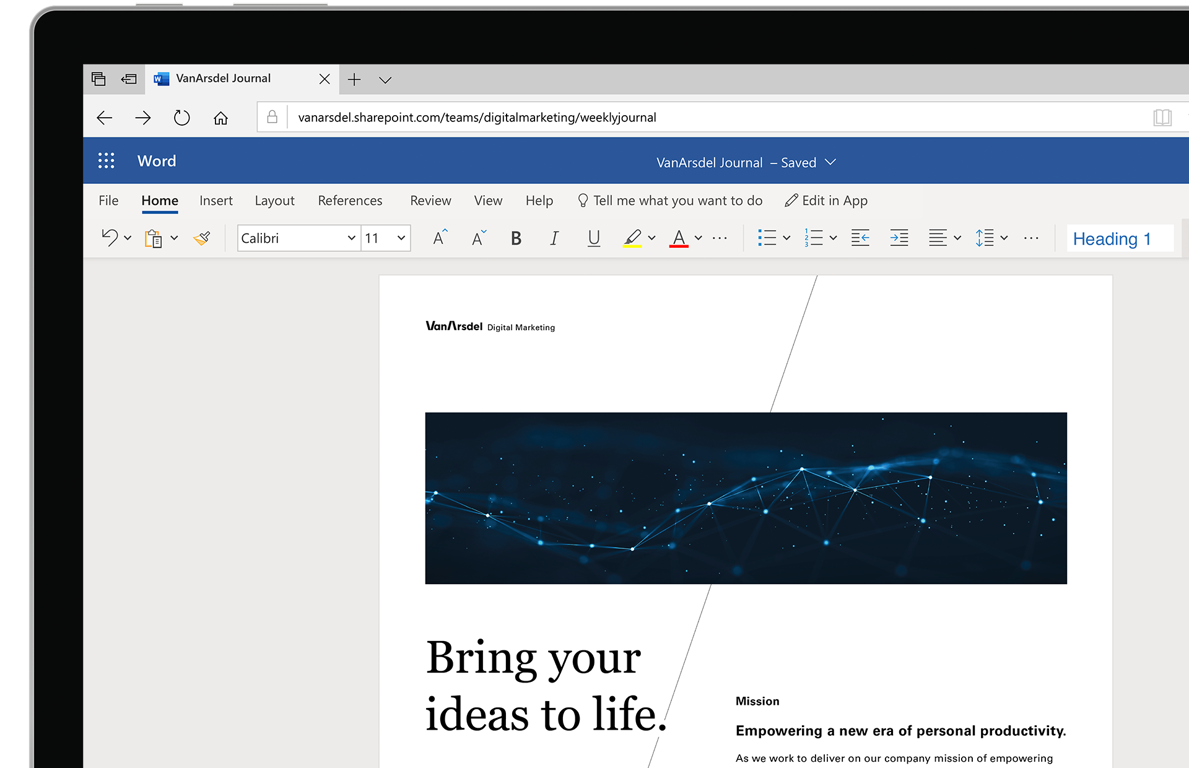Surf the internet in the office, without anyone else noticing, switch quickly from a web browser to a fake Word document so your boss wouldn't notice you're slacking
The Internet is filled with all sort of applications and programs that you could use in order to find information fast. One of such application is Microsoft Word Web Browser.
Word for the web Microsoft Word for the web lets you make basic edits and formatting changes to your document in a web browser. For more advanced features, use Word for the web’s Open in Word command. When you save the document in Word, it is saved on the website where you opened it in Word for the web. The Microsoft Edge browser for business has powerful search features, productivity tools, privacy and security controls, and more. Start piloting today. Use Microsoft Translator in Microsoft Edge browser. The new Microsoft Edge supports translation for more than 60 languages. The browser will automatically prompt you to translate a webpage when when the page you're opening is in a language other than those listed under your preferred languages in. Microsoft Word Web App lets you make basic edits and formatting changes to your document in a.
It's a clever Internet browser that allows you to view web pages at the office, without anyone noticing. It has a clean and simple graphical interface that resembles that of Microsoft Word. Even the application icon is similar to the famous document editor.
Clean and simple graphical interface
The application doesn't take long to install and it doesn't have a complicated setup that you would need to complete before you can check out its features.
It sports a really clean and simple graphical interface that resembles that of Microsoft Word. Microsoft Word Web Browser allows you to surf the Internet at the office, without anyone noticing.
Explore various sections
In order to open a web page, simply type in the address and hit enter. You can search for words inside pages and print them if you'd like. The application comes with some keyboard shortcuts that you can check out and use.
If you press F1, it opens a fake Microsoft Word document, so you can pretend you were working and so no one could tell that you were actually browsing online. It comes with a shortcut for the home page, but you can't navigate through multiple pages and use tabs.
Some shortcomings
While the idea behind this browser is quite clever, the execution not so much. It lacks many of the essential features that other browsers have and it has trouble opening certain pages.
In addition, it doesn't come with incognito mode or any settings that you could adjust. Ad blockers aren't available. Moreover, it takes its time to open web pages which might be quite inconvenient. All in all, Microsoft Word Web Browser is a clever application but don't expect much from it.
Filed under
Microsoft Word Web Browser was reviewed by Alexandra VaidosMicrosoft Word Web Browser 1.0
add to watchlist send us an update
send us an update- runs on:
- Windows NT
Windows 2003
Windows Vista
Windows XP
Windows 2K - file size:
- 2.4 MB
- filename:
- MW_Web_Browser_v1.0.zip
- main category:
- Internet
- developer:
- visit homepage
top alternatives FREE
top alternatives PAID
-->This article provides methods to set Internet Explorer to open Office documents in the appropriate Office program.
Original product version: Internet Explorer 10, Internet Explorer 9
Original KB number: 162059
Symptoms
When you select an HTML link to a Microsoft Office file (such as a Microsoft Word or Excel document), Internet Explorer may open the file in Internet Explorer, instead of opening the file in the appropriate Office program.
Microsoft Word Browser Version
Cause
This behavior may occur if Internet Explorer is configured to host documents for Office programs that are installed on the computer. By default, Internet Explorer is configured to host documents for Office programs.

Resolution
To configure Internet Explorer to open Office files in the appropriate Office program instead of in Internet Explorer, use one of the following methods.
Note
These methods configure Internet Explorer to open Office files in the appropriate Office program for all users.
Method 1 - Use the Folder Options tool
Microsoft Word Browser
Note
If you are running Windows NT 4.0, you may not be able to use the following procedure to configure Internet Explorer to open Office files in the appropriate Office program. If you are running Windows NT 4.0, use method 2.
Note
If you are running Terminal Server on Windows 2000 or Windows Server 2003, you may not be able to select Advanced to open the Edit File Type dialog box in step 4 of this procedure. This issue occurs if the NoFileAssociate policy is enabled. Enabling this policy prevents users (including administrators) from changing file type associations for all users.
To configure Internet Explorer to open Office files in the appropriate Office program by using the Folder Options tool:
- Open My Computer.
- On the Tools menu (or the View menu), select Folder Options (or select Options).
- Select the File Types tab.
- In the Registered file types list, select the specific Office document type (for example, Microsoft Excel Worksheet), and then select Advanced (or select Edit).
- In the Edit File Type dialog box, clear the Browse in same window check box (or clear the Open Web documents in place check box).
- Select OK.
Microsoft Word Web Browser
Method 2 - Edit the Windows Registry
Important
This section, method, or task contains steps that tell you how to modify the registry. However, serious problems might occur if you modify the registry incorrectly. Therefore, make sure that you follow these steps carefully. For added protection, back up the registry before you modify it. Then, you can restore the registry if a problem occurs. For more information about how to back up and restore the registry, see How to back up and restore the registry in Windows.
To configure Internet Explorer to open Office files in the appropriate Office program by editing the Windows registry, set the BrowserFlags DWORD value to a correct value for the appropriate document type. To do this, follow these steps:
Start Registry Editor (Regedt32.exe).
Locate and then select the following registry key:
HKEY_LOCAL_MACHINESOFTWAREClassesLocate the subkey for the specific Office document type. The following table lists the subkeys for several common Office document types.
To locate the subkey for a document type that is not included in this table, find the subkey for the extension that is associated with the document type. The (default) value for that subkey contains the name of the subkey for that document type. For example, the .xls extension is associated with Excel worksheets. Under the .xls subkey, the (default) value contains the string
Excel.Sheet.5. Therefore, the subkey for the Microsoft Excel Worksheet document type is the following subkey:HKEY_LOCAL_MACHINESOFTWAREClassesExcel.Sheet.5After you identify the subkey for the specific Office document type, follow these steps:
If the Office document is a Microsoft Office Excel document, add the following value for all Microsoft Office Excel subkeys except the
Excel.Sheet.5subkey:Value name: BrowserFlags
Data type: REG_DWORD
Value: 8For the
Excel.Sheet.5subkey, add the following value:Value name: BrowserFlags
Data type: REG_DWORD
Value: 9If the Office document is a Microsoft Office Word document or a Rich Text Format document, add the following value for all Microsoft Office Word subkeys except the
Word.Document.12subkey, theWord.DocumentMacroEnabled.12subkey, and theWord.RTF.8subkey.Value name: BrowserFlags
Data type: REG_DWORD
Value: 8For the Word.Document.12 subkey, the
Word.DocumentMacroEnabled.12subkey and theWord.RTF.8subkey, add the following value:Value name: BrowserFlags
Data type: REG_DWORD
Value: 44(Decimal)If the Office document is a Microsoft Office PowerPoint document, add the following value for all subkeys except
PowerPoint.SlideShow.12andPowerPoint.SlideShowMacroEnabled.12.Value name: BrowserFlags
Data type: REG_DWORD
Value: 10(Decimal)For
PowerPoint.SlideShow.12andPowerPoint.SlideShowMacroEnabled.12, delete theBrowerFlagsif it exists.
Select OK, and then quit Registry Editor.
Applies to
- Internet Explorer 10
- Internet Explorer 9
- Office Home and Student 2013
- Office Professional Plus 2013
- Office Standard 2013
- Office Home and Business 2013
- Excel 2013
- PowerPoint 2013
- Word 2013
- Office Starter 2010
- Office Professional Plus 2010
- Office Standard 2010
- PowerPoint 2010
- Office Home and Business 2010
- Office Home and Student 2010
- Office Professional 2010
- Microsoft Word 2010
- Excel 2010
- Microsoft Office Excel 2007
- Microsoft Office PowerPoint 2007
- Microsoft Windows Server 2003 Web Edition
- Microsoft Windows Server 2003 Datacenter Edition (32-bit x86)
- Microsoft Windows Server 2003 Enterprise Edition (32-bit x86)
- Microsoft Windows Server 2003 Standard Edition (32-bit x86)
- Microsoft Office Excel 2003
- Microsoft Office Word 2003
- Microsoft Office PowerPoint 2003
- Microsoft Office Basic Edition 2003
- Microsoft Office Professional Edition 2003
- Microsoft Office Professional Enterprise Edition 2003
- Microsoft Office Standard Edition 2003
- Microsoft Windows XP Home Edition
- Microsoft Windows XP Professional
- Microsoft Windows XP Tablet PC Edition
